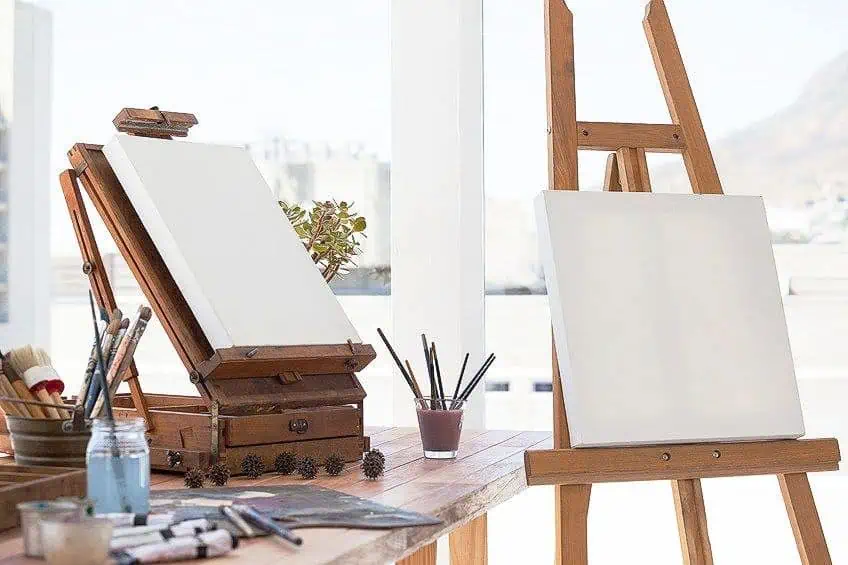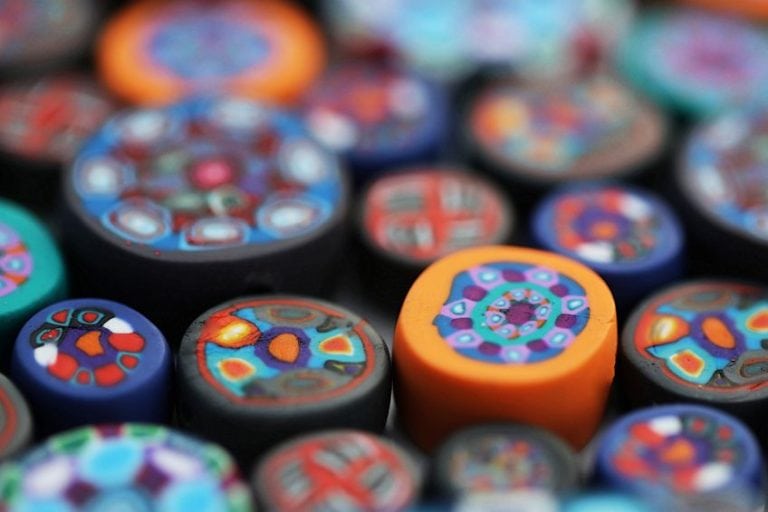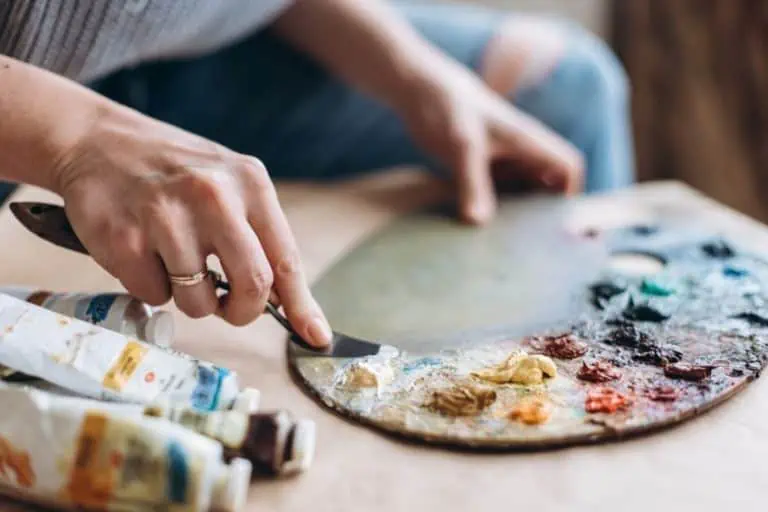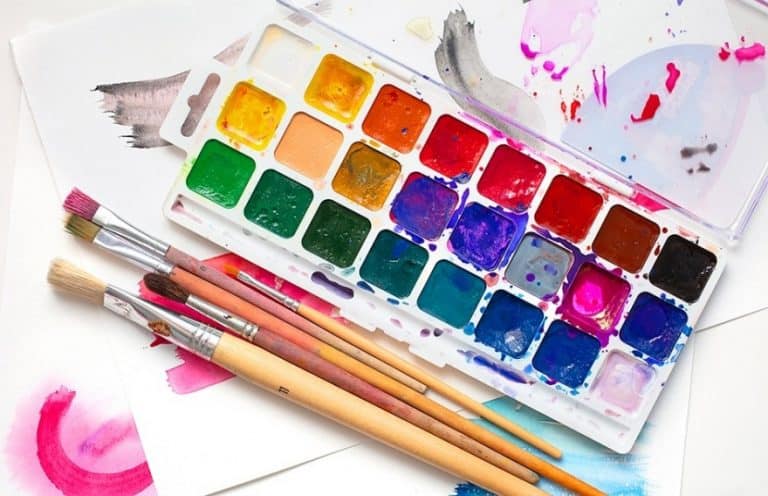Canvas Painting Tips – Learning the Art of Painting on Canvas
This post may contain affiliate links. We may earn a small commission from purchases made through them, at no additional cost to you.
If you have no prior experience in painting on canvases but have an avid interest in doing so, your lack of prior practice may be what is holding you back. Canvases are among the most traditional and exciting surface mediums to work with in painting, but approaching them for the very first time can be an incredibly intimidating prospect for some. How would one even begin to start? Worry not, because in this article, we are going to run through all the tips and tricks needed to get you up to speed with how to approach canvas painting!
Table of Contents
What Is a Canvas?
Before we get into our canvas painting tips, it might be worth what exactly a canvas is, to begin with. It is a versatile material that can be made from a variety of substances that is most typically used as a surface for artwork and other creative projects. It is created using tightly woven fabrics composed of constituents such as linen, cotton, or even synthetic fibers. The traditional purpose of a canvas is to function as a durable and flush surface upon which paint can be applied. In modern times, however, canvases can also be used for sewing, home décor, and crafting.
The weight, texture, and finish of a canvas can vary depending on what you need but the most commonly used is called “stretched canvas”.
This type of canvas is, as the name suggests, tightly stretched over a wooden frame to which it is secured with either staples or nails. The shape and size of these canvases can vary depending on the requirements of the artist, and are sold in both non-primed and pre-primed versions. Since priming is ideal for proper adhesion between the paint and the canvas, we suggest the newcomers opt for the pre-primed variety. The flexibility and durability of canvases make them among the most suitable options for paintwork artists to use as a substrate for their works.

Canvases are the superior option when compared to other traditional painting substrates such as paper. In the past, we used to produce paintings on wooden paneling, but the rigidity of the surface would lead to cracking and warping over time. Initially used for tenting and sails, canvas would soon overtake wood as the most popular medium for painting surfaces. Being highly durable, canvases ensure the greater longevity of the artworks produced on them. Regardless of the size of the canvas you are painting on, the means and methods of working on them remain the same.
Nevertheless, there are a few important things to understand before jumping into how to start canvas painting.
Types of Canvases
Canvases are, for the most part, quite affordable and sturdy. If they are prepared in the correct fashion, paintings produced on them should be able to stand the test of time. However, newcomers might find themselves overwhelmed by the sheer amount of canvas options available to them in most art stores. If you are looking for tips for painting on canvas, your journey should start with learning about the different types of canvases and their applicability.
Cotton Canvas
If you are a beginner, this is probably your best bet. Inexpensive, flexible, and durable, they last longer and do not break the bank, which leaves room for error should you need to restart. Being cheaper than most other types of canvas, they are the perfect thing to practice on and experiment with during the learning process. You can also easily find cotton canvases that come pre-primed.
Provided that you properly prime the surface of your canvas before painting, a cotton canvas can last for ages.

Linen Canvas
Linen canvases are typically more expensive than cotton canvases but for good reason. Compared to cotton, linen is a much stronger material. This means that linen canvases are substantially more durable, thus decreasing the likelihood of warping and offering better overall support to the artwork. The painting surface is also of much better quality, making linen canvases the prime choice for experienced painters.
Beginners are encouraged to only use linen canvases once they have drilled and honed their basic skills on other, cheaper substrates.
Canvas Board
When it comes to affordability, canvas boards are another top contender, which makes them another excellent option for beginner canvas painters. You will find that some canvas boards are produced using primed cotton that has been stretched over fiberboards, while others are simply boards that are primed and then given a stamping to produce the texture of canvas, compared to your typical canvas, canvas boards are far thinner. While this may make them less durable, it does make them more suitable for plein-air painting. One thing to note is that canvas boards are typically less flexible than other traditional styles of canvases.
Whether you like working with a more rigid surface will be a matter of subjective preference.
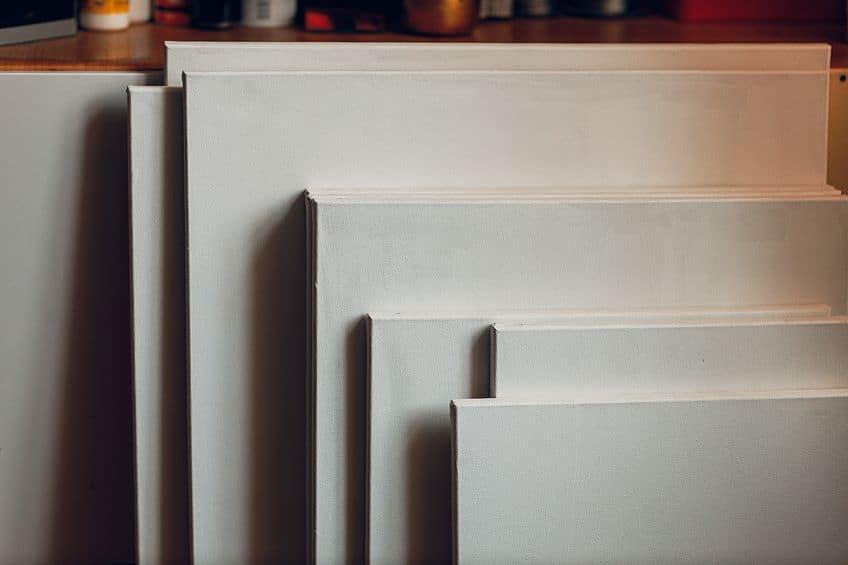
Canvas Alternatives
Canvases are, of course, not the only mediums you could or should paint on. You also have other, sometimes more expensive and professional, substrates such as gesso board to work with. Gesso boards are produced using hardwood with a high density of fibers, which makes them both durable and lightweight. Available in different thicknesses, the benefit of working with gesso boards lies in them offering better brush control.
There are also several metal surfaces that would suffice as an alternative to canvases.
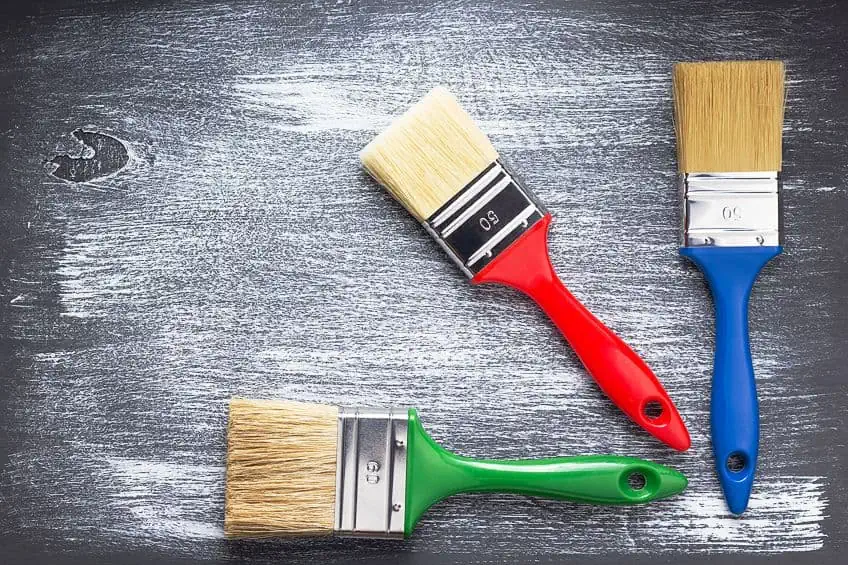
Metal surfaces work decently as a substrate for painting because, naturally, their surfaces are both smooth and non-porous. Better yet, options such as aluminum and copper can be quite lightweight. It is important to keep in mind that metal substrates will still have to be primed before being painted. However, beginners should stick to what is easiest to come by and to work with, which in this case would be a traditional canvas.
Picking Your Paint
Pretty much any sort of paint can be used on canvases, with the two most common options being acrylic paint and oil paint. For the more experienced painters, oil paint is the de facto go-to medium on account of its superior depth of color and versatility. It can also be applied to the canvas using numerous methods to create different styles of painting. Compared to most other types of paint, oil paints can be layered and mixed far easier, which can greatly improve workflow. They do, however, have an incredibly long drying time compared to other paints.
As remarkable as oil paints can be, we would still recommend that first-time canvas painters opt for the use of acrylics instead.
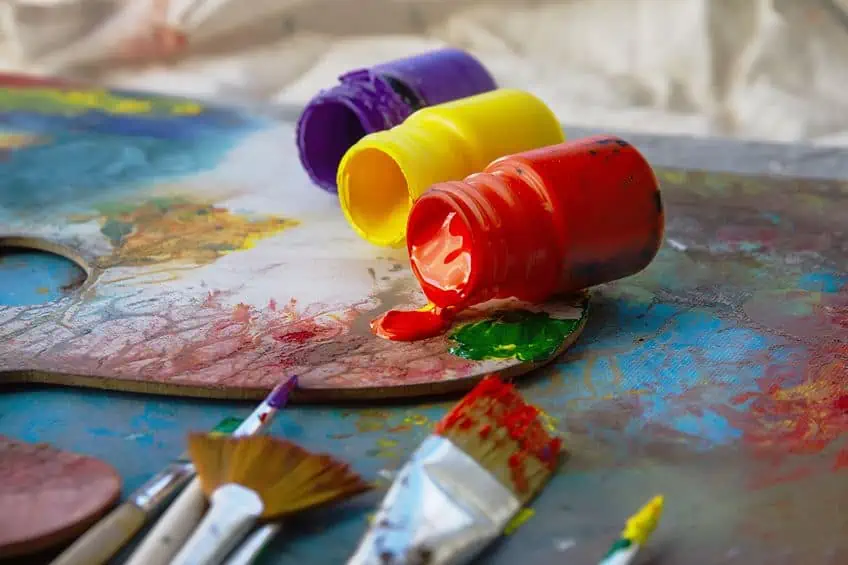
Not only are they incredibly affordable in comparison, but they are also very forgiving in nature and easy to handle. Being water-based, acrylic paints are also water-soluble, which makes them easy to clean up and remove. Better yet, they contain fewer VOCs, which makes them the all-around safer option to work with. Although not as vibrant as oil paints, they are still striking in their color and can be diluted further with water to take on the appearance of watercolors.
They also have a fast drying time, which can assist in expediting projects. This does, however, mean that you must work faster when applying layers since they cure quickly.
The Set-Up
Once you have the canvas that best suits your desires and a painting medium suitable for your project aspirations and skill level, the next thing you will need to do is set up a workspace and gather the required art supplies. The former step is just as important as the latter, and you should decide what sort of situation would work best to afford you the most comfort.
Consider whether you would be happier sitting or standing.

Find an even surface wide enough to fit your canvas if you prefer to paint horizontally. If you prefer to work at a vertical or angled position, consider acquiring an easel. Then, you should get all your paints, brushes, cloth, and palette knives arranged a comfortable distance from your painting.
Paintbrushes
Not all paintbrushes are made equally, especially when it comes to canvas painting. Watercolor brushes, for instance, are absolutely useless when it comes to painting on canvases with oil-based or acrylic paints. Being too delicate, their bristles are likely to get damaged super easily.
When working on canvas medium, the best brushes for the job are acrylic brushes since their high durability will prevent them from breaking or denaturing during use over the course of several separate art projects.
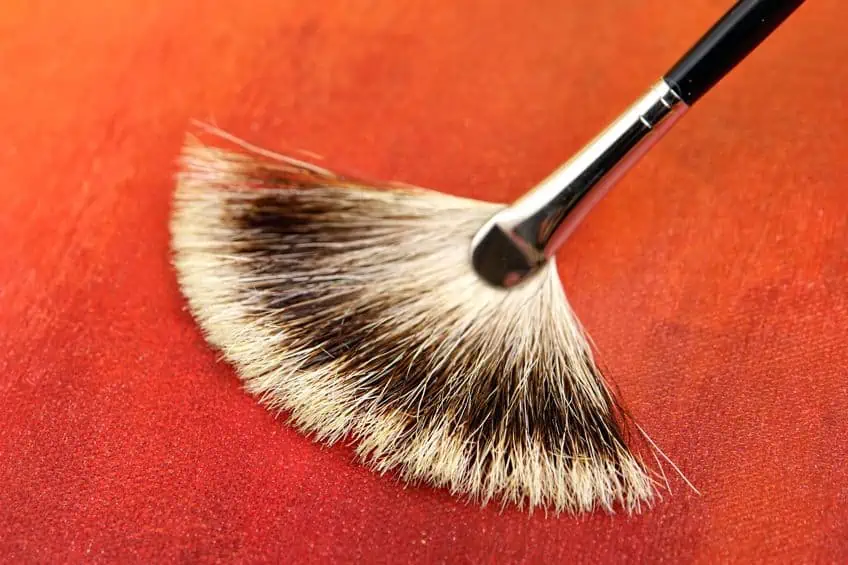
You have the option of purchasing every brush individually but we would recommend that beginners purchase a brush set that offers a wide variety of options. Try to find yourself an affordable yet reliable set that includes round, fan, and flat-tip brushes. Keep in mind that you should always clean your brushes shortly after you are done using them to extend their longevity.
Priming
If you want to learn how to paint on canvas, you should probably learn how to prime them. While it is easy enough to find and purchase pre-primed canvases, it may not always be possible due to either their availability or your budget. Primer is, in essence, a substance that prepares your canvas for the application of paint to ensure maximum adhesion.
If you are working with the more traditional oil-based paints, the best option to go with is oil primer.
However, since you are a newcomer to the art of canvas painting, we recommend that you prime the surface with acrylic gesso in preparation for the use of acrylic paint. One thing to note is that oil paints adhere well to acrylic gesso primers but the same cannot be said of acrylic paints on oil primers. Let us go over gesso primer and how it is used on canvases.
Gesso Primer
You would be hard-pressed to find an art store that does not stock ready-made gesso. It is incredibly similar to, if not completely indistinguishable from, white acrylic paint. The only noticeable difference would be the fact that gesso has a thinner viscosity. After it is applied to a canvas, it will harden on the surface, preparing it for painting. It allows the paint to effectively adhere to the surface and prevents the paint from absorbing into the canvas. You also have other color options apart from white, such as black and yellow.
If you want a particular color of gesso primer as the backdrop of your painting, you can always mix in a bit of acrylic paint.

Many of the stretched canvas products already come pre-primed, however, many recommend that it is a good idea to add another one or two gesso layers for better tooth and absorbency. When applying the gesso, it is best to use a wide and flat brush. Simply dip the brush into the gesso and apply it to the surface horizontally, making sure an even layer is applied to the entire canvas surface.
Gesso Brush Application
We have already mentioned that canvases can be purchased pre-primed. However, experts would recommend that you still apply another layer or two of gesso before painting these canvases. Flat and wide brushes are the most suitable for the application of gesso. Using a brush such as this, you should dip it into the gesso and apply it to the surface of your canvas in a horizontal pattern.
Be sure that your layer of gesso is applied evenly across the entire surface.

If your gesso layer has developed lumps or streaks during the application, you can use a clean brush to smooth or even them out as necessary. After you have achieved the desired gesso layer, allow the primer 20 minutes to an hour to dry completely before you begin painting. This may sound like a long time to the uninitiated, but this waiting time is much shorter than what to expect from oil primers, which take between 24 – 72 hours to dry. To test if your gesso has dried well enough, put your finger against the surface. If, as you remove your finger, you feel the canvas lift with it, you will have to give it more time to dry.
Smoothing Out Gesso Primer
After the gesso primer has dried completely, we advise that you prepare the surface further by gently sanding the surface smooth with fine-grit sandpaper. It is not necessary to do this, but we keenly suggest it for a smoother finish. You may then add a second layer of gesso in the opposite pattern (vertical) and repeat the drying/sanding process. If this is your first time painting on a canvas, two layers of primer should be more than enough.
For the best results during and after painting, give your canvas a day to dry entirely before bringing out the paints.
Benefits of Gesso Primer
Gesso will, first and foremost, allow your paints to adhere to the surface of your canvas much better. However, there are several other benefits of priming with gesso, such as the fact that it allows your colors to pop out with better vibrancy. Furthermore, the texture of the canvas improves, which makes for a more convenient painting experience.
The easier transferral of the paint from the brush to the gesso will also serve to increase the lifespan of your brushes.

And, since the paint cannot sink through the gesso into the canvas, you will be able to enjoy a wider spread during application. You also have a wide variety of gesso options to choose from, from student grade to artist grade. We suggest the prior since it is more affordable. You can get your gesso in the traditional squeeze bottle or in an aerosol can form for easier application.
Canvas Painting Tips
You now know every aspect of how to start canvas painting except for the painting itself, so allow us to get started on this aspect. Once you have properly primed your surface, you can finally whip out the paints you will be using to create your beautiful artwork.
Underpainting
This is something you should consider doing at the beginning of your painting process, as it assists with figuring out the placement of your subjects, the relationship between the values of your painting, and even the overall composition. If done well, it can also bring greater dimension and depth to your paintings. Experts recommend that you use earth colors such as burnt sienna and yellow ochre as your base when applying an underpainting.

Image Sketching
We would keenly suggest that you first sketch out the image you want to paint directly onto the canvas before you break out the brushes. You could use either charcoal or a traditional graphite pencil for this purpose. When you begin to paint, you can use the sketch as a guideline to make the process easier for yourself. If you are creating acrylic art on canvas substrates for the first time, sketching your ideas will afford you a lot more control during the application of the paint.
Canvas Wedges
You may have noticed a little bag with wooden wedges in them when purchasing a canvas. What you should be doing with these is hammering them into the holes on the inside of the canvas in the corners. This creates more tension on the surface of the canvas. You need this tension to be able to control brush strokes better. While on the topic of control, you might also want to know about canvas wedges, which are wooden instruments that can be fastened to the inside holes of the canvas’s corners. This will increase the tension of your canvas, thus allowing for a more taught surface.
What this does is make it easier to control your brush strokes when producing acrylic art on canvas material.

Erasing Mistakes
One of the primary reasons we suggest that beginners use acrylic paint is the fact that mistakes can be easily erased using water, sandpaper, or white paint. If the paint is still wet, you can even remove it using a palette knife before applying linseed oil or water to remove the rest.
Drying
One of the most important tips for painting on canvas we can give to you is to ensure that your completed painting dries under the right conditions. The space in which your painting is left to dry should not be cool, dry, and well-ventilated. Your painting should be out of the way of dust and should not be touched until completely dried. You should give your painting a full day to dry completely if you are working with acrylics.
So, there you have it! Hopefully, we have helped you learn how to paint on a canvas. If you follow these canvas painting tips, you ought to have a much easier time getting familiar with the medium. We wish you the best of luck in getting started with this exciting and gratifying art medium.
Frequently Asked Questions
Must the Edges of the Canvas Be Painted?
It is optional whether or not you want to paint the edges of your canvas. To produce an overall better-looking piece of art, however, you should try to not forego this part. If you want your artwork to appear more contemporary in its aesthetics, you do not want to miss out on the edges as well.
Can I Paint a Canvas Without Priming It?
Yes, you can. However, you are advised to always prime your surfaces before painting to protect them from faster deterioration, mildew, and even molding. Without priming, the canvas will also absorb some of the paint being applied to it, which will mean the use of much more paint. Absorption of the paint into the canvas will also increase the chances of your surface warping or the paint peeling off.
What Are the Benefits of Gesso Primer?
Gesso primer allows your paints to stick to the surface of your canvas better. Gesso primer will also allow the colors of your painting to appear more striking with better vibrancy. The texture of the canvas also improves, which makes for an easier painting experience. The easier transferral of the paint from the brush to the gesso will also increase the lifespan of your brushes. And, since the paint cannot sink through the gesso into the canvas, you will be able to enjoy a wider spread and save on paint.
In 2005, Charlene completed her wellness degrees in therapeutic aromatherapy and reflexology at the International School of Reflexology and Meridian Therapy. She worked for a company offering corporate wellness programs for several years before opening her own therapy practice. In 2015, she was asked by a digital marketer friend to join her company as a content creator, and it was here that she discovered her enthusiasm for writing. Since entering the world of content creation, she has gained a lot of experience over the years writing about various topics such as beauty, health, wellness, travel, crafting, and much more. Due to various circumstances, she had to give up her therapy practice and now works as a freelance writer. Since she is a very creative person and as a balance to writing likes to be active in various areas of art and crafts, the activity at acrylgiessen.com is perfect for her to contribute their knowledge and experience in various creative topics.
Learn more about Charlene Lewis and about us.
